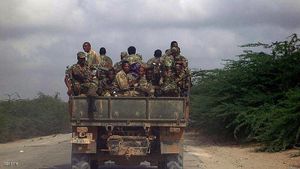أورومو (شعب)
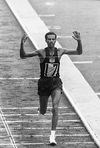 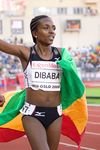 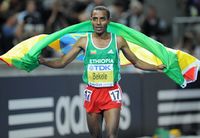 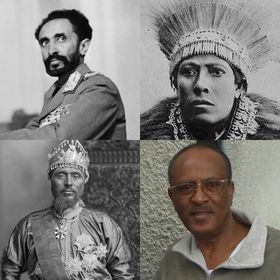 (left to right): Abebe Bikila • Kenenisa Bekele Tirunesh Dibaba Haile Selassie I • Balcha Safo (left to right): Abebe Bikila • Kenenisa Bekele Tirunesh Dibaba Haile Selassie I • Balcha Safo • Ras Mäkonnen • Tilahun Gessesse | |
| التعداد الإجمالي | |
|---|---|
| (30,000,000 [1]) | |
| المناطق ذات التواجد المعتبر | |
| 25,489,000[2] | |
| 818,000[3] | |
| 256,300[4] | |
| 189,000 | |
| 150,563 | |
| 90,000 | |
| 28,000 | |
| 25,664 | |
| 17,580[5] | |
| 12,000 | |
| 10,000 | |
| 3,100[6] | |
| اللغات | |
| Oromo | |
| الديانة | |
| Sunni Islam 47.5%, Ethiopian Orthodox Christianity 30.5%, Protestant 17.7%, Traditional 3.3% | |
| الجماعات العرقية ذات الصلة | |
| Afar • Agaw • Beja • Saho • Somali • | |
الاورومو (أورومو: Oromoo, "القوي"; گعيز: ኦሮሞ, ’Oromo) هي مجموعة عرقية في إثيوپيا، شمال كنيا، وبأعداد قليلة في بعض أجزاء الصومال.[7] ويبلغ عددهم 30 مليون شخص، وهم يشكلون جماعة عرقية قوامها 34.49% من عدد السكان الكلي في إثيوپيا حسب تقديرات 2007.[2][8] لغتهم الأصلية هي الاورومو (وتسمى أيضا أفعان اورومو واوروميفا)، وه يجزء من فرع الكوشتيك من اللغات الأفروآسيوية.
شعب أورومو يعتبر من أكبر هذه المجموعة من حيث عددهم، ورقعة مساحة أراضيهم، إذ يحد أراضي (أوروميا) شرقا صحراء أو جادين التي يطلق عليها الصومال الغربي حاليا، ويحدها من الغرب السودان، ومن الشمال تجراي وإرتريا وعفار، ومن الجنوب كينيا، وتتكون أراضي أوروميا من هضبات وسهول يتخلل تلك الهضبات العالية وديان سحيقة أو نهار سريعة الجريان التي تحمل كميات ضخمة من الطمي. وأراضي أوروميا تعد من أخصب أراضي قارة أفريقيا، تعيش على محصولها الزراعي بعض الدول المجاورة لها.
. . . . . . . . . . . . . . . . . . . . . . . . . . . . . . . . . . . . . . . . . . . . . . . . . . . . . . . . . . . . . . . . . . . . . . . . . . . . . . . . . . . . . . . . . . . . . . . . . . . . . . . . . . . . . . . . . . . . . . . . . . . . . . . . . . . . . . . . . . . . . . . . . . . . . . . . . . . . . . . . . . . . . . . .
الأصول
علاقة الأوروميين بالجزيرة العربية
وللأوروميين علاقة تجارية وسياسية قديمة مع الجزيرة العربية والسودان وقد انتشر الإسلام في قرن أفريقيا على أيدي تجار العرب ولا سيما الجنوبيين منهم، إذ حملوا إلى سكانه الإسلام مع تجارتهم وقد هاجر عدد كبير من تجار العرب إلى المنطقة، وخالطوا سكان المنطقة أثروا فيهم بكثير من عاداتهم وتقاليدهم. والجدير بالذكر أن المذهب الفقهي الذي يتمذهب به أولئك التجار هو المنتشر في المنطقة إلى يوم الناس هذا، وهو مذهب الإمام الشافعي (محمد بن إدريس القرشي).
ومما يذكر بهذه المناسبة أنه يقال إن الملك النجاشي تربى في صباه في الجزيرة العربية حتى أجاد اللغة العربية لذا لم يحتج إلى ترجمان يترجم له كلام رئيس الوفد الذي أرسله رسول الله صلى اللّه عليه وسلم إلى الحبشة (جعفر بن أبي طالب) رضي اللّه عنه في أثناء المحادثة التي جرت بينهما، كما لم يحتج إلى الترجمة فيما تلاه عليه جعفر من القرآن الكريم من سورة مريم في أثناء الحوار الذي دار بينهما في شأن النبي الكريم عليه الصلاة والسلام، وفي شأن مريم عليها السلام واللّه أعلم.
ما قاله المؤرخون عن شعب الأورومو؟
وقد وصف الأوروميين بعض المؤرخين بالبسالة والشجاعة: فيقول الدكتور محمد صبري (مؤرخ مصري) في كتابه (أفريقيا الشرقية) ص 129: "إن الأوروميين يمتازون عن غيرهم بالبسالة والشجاعة والإقدام، ولذلك تتألف منهم خيرة الجنود، وهم من أنشط العناصر الموجودة في شرق إفريقيا في الحرب"، كما وصفهم في الكتاب نفسه "بأن الأوروميين من أكثر الأجناس الأفريقية بهاء وروعة".
وقد رآهم المبشر (كرايف) فأعجب بطلعتهم الحربية الفذة وطول قامتهم، وهم أذكياء يقيمون في المناطق الخصبة، ولهم منها مراع نضرة وأنعام كالهياكل (أي في الضخامة) وهم قوم ذو شجاعة وإقدام، يقيمون في الأماكن الوعرة في أعالي الجبال للبطش بأعدائهم. ومما أجمع عليه المؤرخون الأجانب أن الأوروميين اسـتطاعوا أن يحافظوا على عاداتهم وتراثهم القومي واستقلالهم عدة قرون حتى جاءت الموجات المتتالية من الاستعمار وخاصة الأحباش متعاونين مع أسيادهم الأوربيين فأخضعوهم لسلطانهم. ويقول بعض المؤرخين: "كان ذلك في منتصف القرن التاسع عشر الميلادي، وعند ذلك بدءوا المقاومة مع الغزاة الأجانب".
التاريخ الحديث
الديموغرافيا
تعتبر الاورومو أكبر الجماعات العرقية في إثيوپيا، ولها 74 مجموعة عرقية متنوعة. و95 منهم من الفلاحين والرعاة الرحل، حيث يمارسون أساليب الزراعة القديمة ويعيشون في مستووى اقتصادية منخفض. ويعيش أعداد قليلة منهم في المراكز الحضرية.
سكان أوروميا
يتراوح عدد سكان (أوروميا) ما بين 35-40 مليون نسمة، ويمثل نسبة 50% من سكان أثيوبيا الحالية. ونسبة المسلمين من سكان أوروميا 80%، ونسبة المسيحيين 15%، والباقون وثنيون.
بعض نظام حياتهم
كما قاطع الأوروميون المدارس الإثيوبية للأسباب التي سبق ذكرها، استطاع الأوروميون الريفيون مقاطعة المحاكم الإثيوبية، فلا يتقدمون لها بأي دعوى في قضاياهم، فاصطلحوا أن يعالجوا مشكلاتهم بالتفاوض فيما بينهم حتى تنتهي المفاوضة إلى الصلح، (والصلح خير). وبالنسبة لجريمة القتل اصطلحوا على أن أولياء الدم لا يطالبون بالقصاص، بل يتنازلون إلى الدية والدية تتحملها قبيلة القاتل، لأن إقامة حد القصاص فيه لفت الدولة كما لا يخفى، إلا أن المصلحة تقتضي حل مشكلتهم بالصلح على الدية كما قلنا. ولهم نظم كثيرة خاصة استغنوا بها عن القانون المتبع عند الأحباش، وبعض تلك القوانين خاضع للدراسة حتى يرى هل يوافق الشريعة الإسلامية أو فيها نوع من المخالفة للشريعة!!
جبهة تحرير الأورومو
رئيس جبهة تحرير الأورومو:هو السيد \ داود ابسا ايانا ومقرها الان اسمرا ارتريا
مقر قيادة العسكريةللجبهة فهي أراضي أوروميا الواسعة، وليس في الإمكان أن نحدد الآن المقر الرسمي، إلا أننا نستطيع أن نقول: ان الموقع الرسمى لهم http://www.oromoliberationfront.org/sbo.html
موقف جمهورية إرتريا فهي تعرف من هذه الجبهة ما لا يعرف غيرها.
الجماعات الفرعية
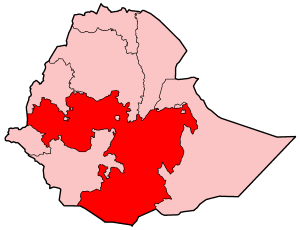
البورانا وتشمل:
وينقسم كل منهم إلى تقسيمات فرعية أخرى.
البارنتو/بارينتوما، وتشمل:
- والو اورومو
- إيتو ارومو
- كارايو ارومو
- أننيا اورومو
- عفران كالو
- ألا اورومو
- اوبورا اورومو
- بابيله اورومو
- داگا اورومو
- نوله اورومو
- كارسو
- أرسي اورومو
- كالو
The Borana which include:
- Samaalo
- Walaabuu
- Rayyaa
- Karrayyuu, who live along the Awash valley in east Shawa as well as West Hararge
- Walloo
- Macca Oromo, living between Didessa River and the Omo River, and south into the Gibe region
- Sirba
- Libaan
- Jaawwii
- Daal'ee
- Jiddaa
- Tulama Oromo, who live in the Oromia Region around Addis Ababa
- Daaccii
- Oboo
- Diigaluu
- Eekka
- Guulaalee
- Gumbichuu
- Konnoo
- Yaayee
- Galaan
- Aabuu
- Adaa
- Gaduulaa
- Jaarsoo
- Jiddaa
- Libaan
- Soddo
- Libaan
- Odituu
- Tummee
- Oboo
- Bachoo
- Garasuu
- Illu
- Meexaa
- Uruu
- Waajituu
- Jiillee
- Daaccii
- Rayyaa
- Walaabuu
- Ormaa
- Dayyaa
- Komboo
- The Guji Oromo, who are inhabiting the southern part of Oromia, neighboring the Borana Guttuu amd the Sidama People.
- Hokkuu
- Maaxii
- Uragaa
- The Guji Oromo, who are inhabiting the southern part of Oromia, neighboring the Borana Guttuu amd the Sidama People.
- The Borana Oromo, also known as Boraan Guttuu, who live in the Borena Zone, which includes Moyale. They also live in Kenya and parts of Somalia.
- The Gabra Oromo, who live in north Kenya along the Moyale border region
- The Warday Oromo, who live in southern Somalia, and North Eastern Kenya
And countless subdivisions.
The Bareento/Bareentuma which include:
- The Walloo Oromo, who are the northernmost group, and live predominantly in the Oromia Zone of the Amhara Region, as far north as Lake Ashenge, and are also found in the southern Raya Azebo woreda in the Tigray Region.
- Warra Baboo
- Warra Illu
- Warra Himanoo
- Warra Qallu
- Warra Qoboo
- Warra Rayyaa
- Warra Wayyuu
- Warra Yejju
- The Marawa Oromo, who live in the Western part of the Harargee zone.
- Ittu Oromo
- Galaan Ittu
- Warra Alga
- Warra Babbu
- Warra Gaduulaa
- Warra Gaammoo
- Kurraa Ittu
- Warra Addayyoo
- Warra Arojji
- Warra Bayye
- Warra Wacallee
- Warra Wayye
- Warra Qallu
- Galaan Ittu
- Ittu Oromo
- The Afran Qallo which refers to the 4 decedents of Qallo, who are:[9]
- Ala Oromo, living west of the city of Harar and the Erer River
- Warra Abbadho
- Warra Abbayi
- Warra Arroojji
- Warra Dirammuu
- Warra Erer
- Warra Galaan
- Warra Meettaa
- Warra Nunnu
- Warra Sirbaa
- Warra Tulamma
- Oborra Oromo , living between Ituu and Ala Oromo
- Babille Oromo, living east of the Erer River in the Oromia Region
- Akichu Oromo
- Warra Miyyoo
- Wara Bitto
- Warra Daayyo
- Warra Luujo
- Warra Ittu
- Warra Kiyo
- Warra Heebaan
- Warra Kurto
- Warra Obo
- Warra Igoo
- Warra Asaabo
- Warra Eejjeso
- Gharrii Komboo
- Hawiyaa
- Akichu Oromo
- Dagaa Oromo, who live in and east of Dire Dawa, north of Harar, and as far as the northeastern corner of the Oromia Region
- Humee Oromo
- Jaarsoo Oromo
- Warra Walabu
- Warra Sayyo
- Warra Oga
- Warra Ugadiiho
- Warra Dowarro
- Warra Dhaqqa
- Noolee Oromo
- Warra Halele
- Warra Gatoo
- Warra Faxoo
- Manaa Usmaan
- Oddaa
- Mayya
- Chaffee
- Mayya
- Jaarso
- Liibaan
- Galaan
- Garad
- Oddaa
- Manaa Omaar
- Manaa Usmaan
- Warra Mammaa
- Warra Mahammad
- Ala Oromo, living west of the city of Harar and the Erer River
- The Ambo(Ambato)
- Arsi Oromo, who primarily live in the Arsi Zone of the Oromia Region (which is named for them) as well as the Bale Zone
- Mandoo Arsi
- Warra Buulalaa
- Warra Wacalee
- Warra Waajii
- Warra Ilaan
- Warra Hawaxa
- Warra Utaa
- Warra Jawwii
- Sikko Arsi
- Warra Waayyuu
- Warra Harawaa
- Warra Biltuu
- Warra Kajawaa
- Warra Rayyaa
- Mandoo Arsi
- Arsi Oromo, who primarily live in the Arsi Zone of the Oromia Region (which is named for them) as well as the Bale Zone
- The Humbannaa Oromo, who live south of the Ittu and west of the Erer River;
- Aniyaa Oromo
- Warra Aanaa
- Warra Baboo
- Warra Biduu
- Warra Dambu
- Warra Kolee
- Warra Maccaa
- Warra Malkaa
- Aniyaa Oromo
- Dhumuga Oromo
- Warra Heela
- Warra Akkiyaa
- Warra Kajaammo
- Warra Heebana
- Warra Asallaa
- The Ormaa of Kenya, who are said to have originated from the Harargee area.
There are also many further subdivisions.
المصطلحات
المجتمع والثقافة
. . . . . . . . . . . . . . . . . . . . . . . . . . . . . . . . . . . . . . . . . . . . . . . . . . . . . . . . . . . . . . . . . . . . . . . . . . . . . . . . . . . . . . . . . . . . . . . . . . . . . . . . . . . . . . . . . . . . . . . . . . . . . . . . . . . . . . . . . . . . . . . . . . . . . . . . . . . . . . . . . . . . . . . .
گادا
الديانة
علاقاتهم بالبجا
الأورومو هم أحد الشعوب الكوشية ويتحدثون بلغة كوشية قريبة في مخارج حروفها من لغة البداويت الكوشية، وهناك علاقة ما وارتباط ما بين الأرومو والبجا، وتوجد آثار كثيرة تدل على هذه العلاقة، منها[10]:
- تلك الآثار المنتشرة في بوادي البجا بولاية البحر الأحمر وولاية كسلا وتسمى الأكرا تهيل وهي آثار قديمة جداً. ويصر الآهالى من البجا حتى الآن أن من بنى هذه الآثار قوم يسمونهم آروم.
- أيضاً توجد مدينة بإسم أروما في ولاية كسلا.
- وكذلك هناك وسم أروم، وهو وسم يعمل على أبل قبيلة الكرباب وهى فرع من فروع الإمارأر.
- ثم إن المتتبع لحركة هجرات البجا عبر التاريخ يجدها دائماً تتجه إلي الجنوب الغربى، فبعض القبائل التى كانت حول سواكن بعد مرور ألف سنة أصبحت الآن في اقصى جنوب منطقة البجا بل بعضها داخل إرتريا أو على تخوم إثيوپيا.
يجمع المؤرخون أن نهاية مملكة أكسوم في القرن الثامن الميلادى كانت على يد جحافل من البجا. قد كان شعب البجا قديما حسب ما ذكره ابن حوقل في كتابه "صورة الأرض" يضم عدة مجموعات بلغات مختلفة، لذا يحتمل أن الأرومو كانوا واحدة من هذه المجموعات، ثم حدثت لهم هجرات بإتجاه الجنوب الغربي حتى استقروا في موطنهم الحالي المعروف اليوم.
التسمية
التقويم
الحاضر
مشاهير الاورومو
- علي بيرا، مغني ومؤلف وكاتب أغاني
- المهندس Ayana Birru مخترع الآلة الكاتبة الأمهرية
- Tadesse Birru, General of Haile Selasse I "Fatno-Derash" para-military, trained Mandela, key Macha-Tullama leader[11]
- Girma Wolde-Giorgis- President of Ethiopia under Meles Zenawi
- Sultan Abba Jifar II, ruled Jimma and surrounding areas
- Ras Ali II of Yejju, Enderase or Regent of the Ethiopian Emperor during the reigns of Sahle Dengel and Yohannes III who was also his step-father. Driven from power by Emperor Tewodros II, Father of Empress Tirunesh Ali, first consort of Emperor Tewodros II.
- Empress Menen Liben Amede, wife of Emperor Yohannes III, and mother of the Enderase Ras Ali II of Yejju by an earlier marriage. She was a significant political and military figure in her own right.
- Empress Wubit of Yejju (also known as Welete Bersabe) wife of Emperor Iyasu II and mother of Emperor Iyoas I, rival of her mother-in-law Empress Mentewab with whom she struggled for power during the reign of her son Iyoas.
- Solomon Deressa - Oromo poet, screenwriter (most of his work in Amharic)
- Empress Tirunesh Ali Daughter of Ras Ali II of Yejju and granddaughter of Empress Menen Liben Amede, much loved first wife of Emperor Tewodros II
- Bulcha Demeksa, Chairman of Oromo Federalist Democratic Movement (OFDM)
- Dawud Ibsa Ayana, ex-chairman of the Oromo Liberation Front
- Ahmad Buna - led & helped to unite MTWA and Bale resistance, co-founded OLF
- Dejazmach Ali AbaJiffar- leader of Wollo Oromo, maternal-side Grandfather of Haile Selassie I
- Dejazmach Balcha Safo (also known as "Balcha Abba Nefso" (pictured at the head of this page) Nobleman and leading military and conservative political figure during the reigns of Emperor Menelik II, Empress Zewditu and Emperor Haile Selassie veteran of the Battle of Adwa (1896) and a resistance leader against the Fascist occupation of Ethiopia (1936–1941).
- Dejazmach Gebre Igziabiher Moreda (born Kumsa Moreda) Last King of the Oromo Kingdom of Leqa Lekempt, Dejazmatch under Menelik, then leader of the separatist "Western Galla Confederation" in 1936
- Dejazmach Kassa Wolde Mariam Heir to the Oromo Kingdom of Leqa Qallam, grandson-in-law of Emperor Haile Selassie I, served as senior secretary to the Emperor, President of Haile Selassie I University, and governor-general of Wellega.
- Dejazmatch Fikre Selassie Habte Mariam Heir to the Oromo Kingdom of Leqa Lekempt, grandson of Dejazmatch Gebre Igziabiher Moreda, grandson-in-law of Emperor Haile Selassie I, and son-in-law of Emperor in Exile Amha Selassie I, governor-general of Wellega.
- Iyasu V of Ethiopia (1913–1916), designated Emperor of Ethiopia, grandson and designated heir of Emperor Menelik II and son of King Mikael of Wollo
- Haile Selassie I (1930–1974), Emperor of Ethiopia
- Ras Makonnen - Father of Haile Selassie I, Abegaz(commander in Chief) of the Battle of Amba Alage(December 7, 1895), Commanding General of the 1st Battle of Mekelle, Commander of the Armies of Harer at Battle of Adwa, and cousin of Emperor Menelik II
- Ras Gobana Dacche, famous and controversial 1800s Oromo figure and leading advisor and military supporter of Emperor Menelik II
- Judge Birtukan Mideksa - Chairwoman of Unity for Democracy and Justice (UDJ - Andenet) party
- Sheikh Mohammed Rashad Abdulle, scholar; translated the Qur'an into the Oromo language
- Negasso Gidada, former Ethiopian president
- Debela Dinsa Member of the Derg which deposed Emperor Haile Selassie and the person who read out the act of depostion to the Emperor, served as Derg era governor of the Shewa Administrative Region.
- Reverend Gudina Tumsaa, Former Chairperson of the Ethiopian Evangelical Church Mekane Yesus
- Baaroo Tumsaa, Founder of the OLF
- Sophia Yilma Deressa - Vice-President of Ethiopian Democratic Party (EDP)
- Tadesse Liben - short story writter
- Lencho Leta, co-founder of the OLF
- Abadula Gemeda, President of Oromia Regional State, Chairman of OPDO
- King (Negus) Mikael of Wollo, Michael Ali of Wollo (born Mohammed Ali)
- Dr. Merera Gudina, chairman of the Oromo People's Congress, formerly ONC, part of UEDF and MEDREK
- Alemayehu Gemeda, founder of the famous EthioTube -Broadcast Ethiopia (Ethiopia's Youtube site)
- Liben Eabisa, Founder and Editors of Tadias Magazine[12]
- Onesimos Nesib, evangelist and translator of English Bible into Afaan Oromo[13]
- Merdekios, Founder of Yeroo, the first Qubee private Oromo newspaper[14]
- Dirribi Demissie incumbent president of Macha and Tulama Association (MTA)
- Brigadier General Teferi Benti, Senior staff officer in the Imperial Army, later appointed Chairman of the Derg Military Junta after the fall of the monarchy. Removed from power and killed in power struggle with Mengistu Haile Mariam.
- Haile Mariam Gamada, instrumental in the founding of the Macha-Tuullama Welfare Association (MTWA)
- Tilahun Gessesse, singer
- Tsegaye Gabre-Medhin, poet, playwright
- General Waqo Gutu, leader of the Bale revolt founding the first Oromo separatist movement.
- General Jaagamaa Keello/Jagama Kello, Oromo-Ethiopian general, defeated the Bale rebellion, also fought Italians
- Fitawrari Woldemikael Guddessa, Grandfather of Emperor Haile Selasie I and commander of Ethiopian armed forces
- Ahmad Taqi, early nationalist
- Beka Yahya, One of the first Oromo actors in the United States. Well known in the Oromo community
- B/General Kemal Gelchu, incumbent chairman of OLF faction
- General Hailu Gonfa, incumbent commander of the Oromo Liberation Army, the military wing of the OLF
- Galasa Dilbo, co-founder and ex-chairman of OLF, incumbent leader of "transitional" OLF faction
- Lij Yilma Deressa, long time Finance Minister of Ethiopia under Emperor Haile Selassie I
- Haile Fida founder of the MEISON political party
- Sheikh Bakri Sapalo, inventor of a writing system for the Oromo language
لاعبون اولمبيون اورومو
- عبدوس إبراهيم - American soccer (football) player, FC Dallas, Toronto FC.
- Berhane Adere- 2 World Golds, won the IAAF World Half Marathon Championships
- Abebe Bikila - 2 Olympic Golds, first African and Ethiopian to receive a gold medal in the Olympics (marathon; ran barefoot)[بحاجة لمصدر]
- Kenenisa Bekele - 3 Olympic Golds, 6 World Golds, Ethiopian long distance runner, Olympic champion, world record holder.
- Tariku Bekele- 1 World Gold, Ethiopian long distance runner and younger brother of Kenenisa Bekele.
- Gelete Burika- 1 World Junior Gold, 1 World team gold, Long distance runner
- Meseret Defar - 1 Olympic Gold, 4 World Golds, Ethiopian middle,long-distance runner,Olympic champion
- Genzebe Dibaba- 1 World Junior Gold, Long Distance runner (youngest Dibaba sister)
- Ejegayehu Dibaba- 1 World Team Gold, Ethiopian long-distance runner (older sister of Tirunesh Dibaba and Genzebe Dibaba)
- Tirunesh Dibaba - 2 Olympic Golds, 9 World Golds, Ethiopian long-distance runner, multi-Gold winner at World championships (middle Dibaba sister and cousin of درارتو تولو)
- Fikru-Teferra Lemessa- striker in Ethiopian national football team and Czech soccer club.
- Fatuma Roba - 1 Olympic Gold, Long Distance runner and 1996 marathon winner.
- Sileshi Sihine - Ethiopian long-distance runner
- Mestawet Tufa- 2 World Team Golds, Long Distance runner
- درارتو تولو - 2 Olympic Golds, 1 World Gold, Long Distance runner and Gold Winner at the Olympics. (Cousin of the Dibaba sisters.)
- Gete Wami - 1 World Gold, cross country and track runner.
- مامو ولده - 1 Olympic Gold, Ethiopian long-distance runner, winner of the marathon at the 1968 Summer Olympics
- مريم يوسف جمال - 1 World Gold, Ethio-Bahraini middle distance runner
. . . . . . . . . . . . . . . . . . . . . . . . . . . . . . . . . . . . . . . . . . . . . . . . . . . . . . . . . . . . . . . . . . . . . . . . . . . . . . . . . . . . . . . . . . . . . . . . . . . . . . . . . . . . . . . . . . . . . . . . . . . . . . . . . . . . . . . . . . . . . . . . . . . . . . . . . . . . . . . . . . . . . . . .
نزاعات
نزاع الأورومو
في 1 نوفمبر 2020، لقى 54 مدنياً من العرقية الأمهرية مصرعهم على يد جيش تحرير الأورومو في منطقة أوروميا بغرب إثيوپيا. يعتقد الأورومو أن تواجد الأمهرة في منطقة أوروميا ليس شرعياً، وأنهم مفروضين عنوة بدعم من مليشيا الشفتا.
وقال أحد الناجين أن الهجوم وقع بعد أن انسحب الجنود المتمركزون في المنطقة فجأة بدون تفسير، تاركين المكان مفتوحاً أمام مقاتلي جيش تحرير أورومو. وأضاف بعد أن جمعونا فتحوا النار علينا، قبل أن يقوموا بنهب المواشي وحرق المنازل، وأنه شاهد سقوط أكثر من 50 جثة، وعدد غير معروف من المصابين بالرصاص.[15]
انشق جيش تحرير أورومو، الذي يقال أنه يضم بضعة آلاف عن جبهة تحرير أورومو، وهي جماعة معارضة تخلت عن الكفاح المسلح منذ عودة قادتها من المنفى بعد تسلم آبي أحمد السلطة عام 2018. وترى حركة أمهرة الوطنية، وهي حزب معارض، أن الهجوم استهدف أفراداً من جماعة الأمهرة العرقية، وهي ثاني أكبر جماعة عرقية في إثيوپيا بعد الأورومو.
انظر أيضاً
المصادر
- ^ Oromo people, Joshua Project
- ^ أ ب Central Statistical Agency (2008). "TABEL [sic] 5: POPULATION SIZE OF REGIONS BY NATIONS/NATIONALITIES (ETHNIC GROUP) AND PLACE OF RESIDENCE: 2007" (PDF). Census 2007. Addis Ababa: Central Statistical Agency. p. 66. Archived from the original. You must specify the date the archive was made using the
|archivedate=parameter. http://www.csa.gov.et/pdf/Cen2007_firstdraft.pdf. - ^ "Ajuran, Garreh, Orma, Oromo-Boran, Oromo-Sakuye, Oromo-Gabbra, Rendille".
- ^ Oromo-Tulama, Oromo-Southern
- ^ Statistics Canada - Ethnocultural Portrait of Canada Highlight Tables, 2006 Census
- ^ Oromo-Tulama
- ^ Merriam-Webster Inc, Frederick C. Mish, Merriam-Webster's Collegiate Dictionary, (Merriam-Webster: 2003), p.876
- ^ The CSA estimates a population growth of 7.6% between the time the census was conducted and the date of its approval: "Ethiopia population soars to near 77 million: census". Google News. AFP. 4 December 2008. Retrieved 5 December 2008.
'We carried out a census in May 2007 and it shows that there were 73,918,505 people at that time,' Central Statistics Agency chief Samya Zakarya told AFP.'But based on a projection of an annual growth rate of 7.6 percent, Ethiopia's population up to this month is 76,947,760.'
{{cite news}}: Unknown parameter|curly=ignored (help) - ^ S. Waldron, "The political economy of Harari-Oromo relationships (1554-1975)", p. 7 (Forced migration Online website, accessed 3 July 2009)
- ^ "الأورومو والبجا". اذاعة مستقبل اوروميا للاخبار. 2021-02-18. Retrieved 2021-02-27.
- ^ Tadesse Birru
- ^ Tadias Magazine
- ^ Onesimos Nesib, translator & missionary
- ^ Oromo Ethiopian Newspaper
- ^ "إثيوبيا.. اتهام مجموعة مسلحة بقتل مدنيين خلال هجوم "مروع"". سكاي نيوز عربية. 2020-11-02. Retrieved 2020-11-03.
وصلات خارجية
قراءات إضافية
- Mohammed Hassan, The Oromo of Ethiopia, A History 1570-1860. Trenton: Red Sea Press, 1994. ISBN 0-932415-94-6
- Herbert S. Lewis. A Galla Monarchy: Jimma Abba Jifar, Ethiopia 1830-1932. Madison: The University of Wisconsin Press, 1965.
- "RIC Query - Ethiopia". INS Resource Information Center. Retrieved October 8, 2005.
{{cite web}}: Unknown parameter|dateformat=ignored (help)
- CS1 errors: unsupported parameter
- "الجماعات العرقية ذات الصلة" تحتاج تأكيد
- Articles using Template:Infobox ethnic group with deprecated parameters
- Articles using infobox ethnic group with image parameters
- Articles containing أورومو-language text
- Pages using Lang-xx templates
- Articles containing Ge'ez-language text
- Articles with unsourced statements from February 2007
- أورومو (شعب)
- جماعات عرقية في إثيوپيا
